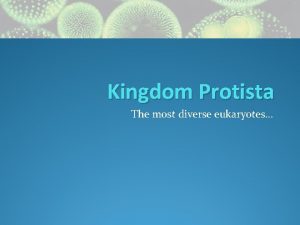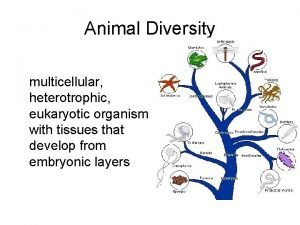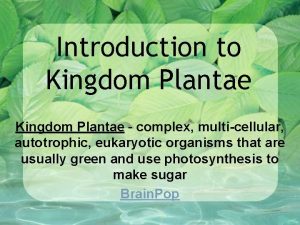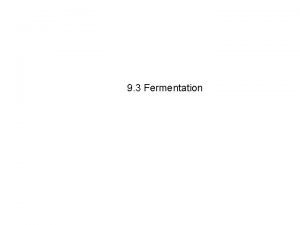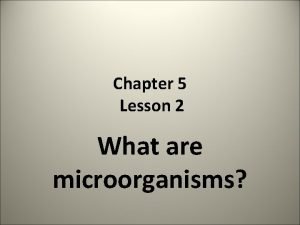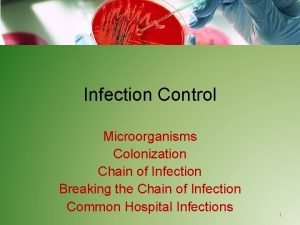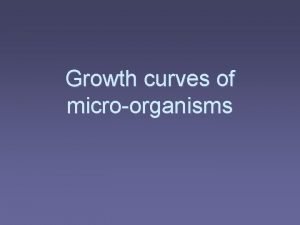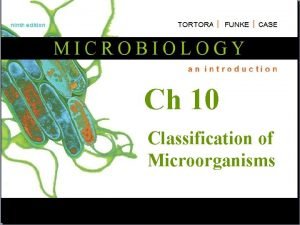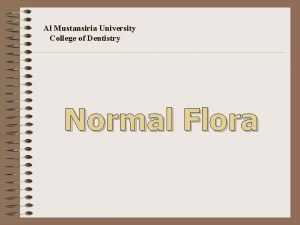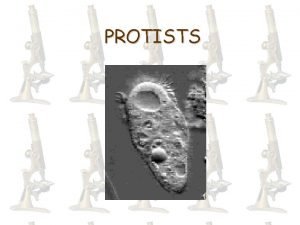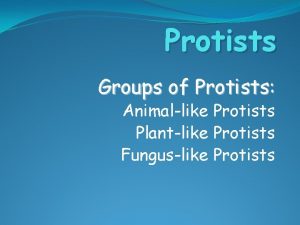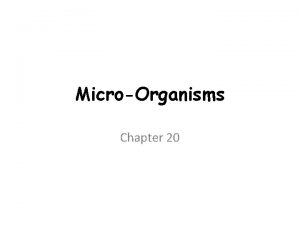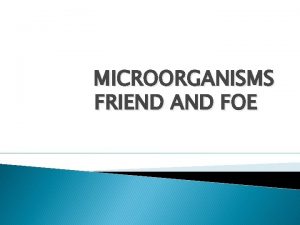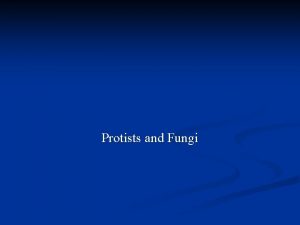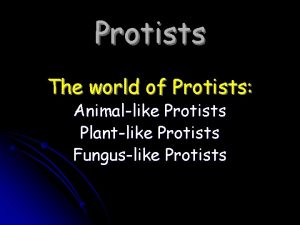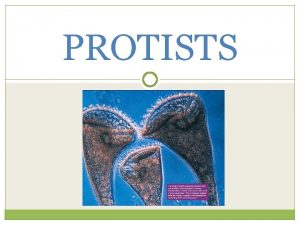Protists Eukaryotic Organisms Protists p Protists Eukaryotic microorganisms













- Slides: 13

Protists Eukaryotic Organisms

Protists p Protists: Eukaryotic microorganisms in the Protist family.

Protists p Typically have external structures for motility. These include… n Flagella: Two central microtubules & 9 pairs of peripheral microtubules (a 9+2 arrangement) surrounded by a membrane. p n Found in protozoa & algae, but only have one or two. Cilia: Shorter & more numerous than flagella – have the same basic chemical composition & structure. p Beat together in a coordinated pattern along the surface to create a “wave”.

Protists n Pseudopodia: “False feet” that are temporary projections of cytoplasm associated with amoeboid movement. p Cytoplasmic Streaming: Movement that occurs along a surface via pseudopodia.

Classes of Protists p Protists are divided into 3 groups: n n n Plant-like Protists aka Algae Fungus-like Protists Animal-like Protists

Plant-Like Protists p Plant-Like Protists aka Algae: Organisms with chloroplasts & carry on photosynthesis. n n n Typically found in moist & sunny environments. Most have a cell wall & one or two flagella for motility. Most reproduce via binary fission. Includes dinoflagellates, diatoms, & euglenoid dinoflagellates. Not associated with human disease.

Fungus-Like Protists p Fungus-Like Protists: Known as oomycota. n n p Use sexual reproduction instead of asexual. Spend most of their life cycle as diploid cells, which are the result of a union of two haploid gametes during sexual reproduction. Includes water molds & slime molds. n Water molds cause agriculturally relevant diseases. p n n p Ex. Downy mildew on grapes, late blight on potatoes, etc. Slime molds cause mildew & are sometimes classified as fungi. NEITHER type cause disease in humans! Saprophytes: Class that receives nutrients by decomposing dead organisms – slime molds fall into this category!

Animal-Like Protists p Animal-Like Protists aka Protozoa: Mostly unicellular organisms, possibly found in colonies. n n n p Commensalism: The process of living in or on other organisms without harming them. n p Most are free living Many live in watery environments Can encyst (close itself in a cyst) to preserve genetic material in unfavorable conditions. Protists can do this! Parasitism: The process of living in or on another organism while taking nutrients from that organism – may or may not harm them. n Protists can do this too!

Protozoa p There are 4 main classes of Protozoa, ALL of which have members that can cause human disease… n n Mastigophorans Sarcodines Apicomplexans Ciliates

Mastigophorans p p p Mastigophorans: Mainly free-living, unicellular, flagellated organisms. Some have symbiotic (helpful) relationships with plants & animals. Some parasitize humans. n n Trypanosoma: Causes African sleeping sickness. Leishmania: Causes skin lesions or systemic disease with fever. Giardia: Causes severe diarrhea. Trichomonas: Causes vaginal inflammation. bb

Sarcodines p Sarcodines: Protozoans that move & capture food by forming pseudopodia. n n Feed mainly on other microorganisms, including other protozoa & algae. Causes Ameobic dysentery.

Apicomplexans p Apicomplexans: Protozoans that are parasitic. n n n p p Parasitic Immobile Typically have complex life cycles requiring more than one host. Plasmodium: The parasite that causes malaria. Toxoplasma gondii: Infects domestic cats & can be passed on through handling of feces – causes damages to the unborn fetus of a pregnant human.

Ciliates p Ciliates: The largest group of protozoans, categorized by their large number of cilia. n n p Have cilia over most of their surfaces. Contractile Vacuole: A well-developed organelle that regulates cell fluid. Balantidium coli: The only ciliate to cause human disease – causes dysentary.
 Kingdom protista
Kingdom protista Kingdom fungi and kingdom plantae similarities
Kingdom fungi and kingdom plantae similarities Contains the most diverse eukaryotic organisms
Contains the most diverse eukaryotic organisms Heterotrophic eukaryotic organisms
Heterotrophic eukaryotic organisms Eukaryotic vs prokaryotic
Eukaryotic vs prokaryotic Plantae multicellular
Plantae multicellular Competitive interaction
Competitive interaction Uni and multicellular organisms
Uni and multicellular organisms Fermentation in microorganisms
Fermentation in microorganisms Harmful microorganisms
Harmful microorganisms Tuberclerosis
Tuberclerosis Learning objectives of microorganisms
Learning objectives of microorganisms Microorganisms meaning
Microorganisms meaning What is the microorganisms
What is the microorganisms


